The Colorful, Sometimes Odd Ways America Celebrates the Fourth of July
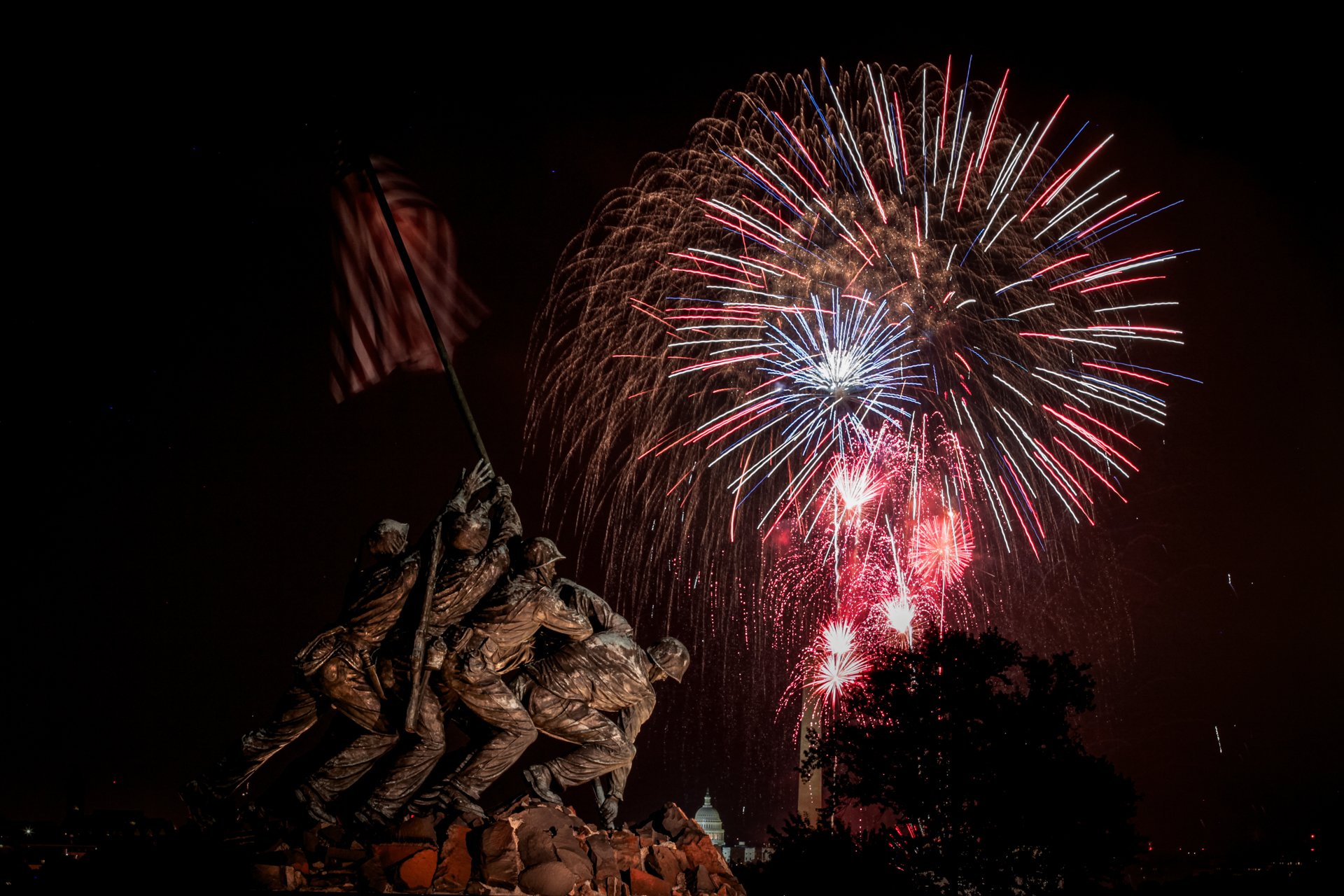
The United States Marine Corps War Memorial, better known as the Iwo Jima Memorial, is seen in Arlington, Virginia, on Monday, July 4, 2011, as fireworks burst over Washington during the annual Fourth of July display. The Washington Monument and the Capitol can be seen in the distance. AP photo by Carolyn Kaster.
The Declaration of Independence may have been finalized and approved on July 4, 1776, but it wasn’t until Aug. 2 that most of the delegates traveled to Philadelphia to sign it. So the first Independence Day celebration actually took place on the one-year anniversary in 1777. The day included fireworks, a hallmark of Fourth of July celebrations to this day, and barbecues — because every celebration needs meat cooked outdoors.
Fourth of July observances didn’t become commonplace until after the War of 1812. By the 1870s, July 4 was the “most important secular holiday on the calendar,” according to the Library of Congress. US Congress declared Independence Day an unpaid federal holiday on June 28, 1870, then adjusted it to a paid federal holiday in 1938.
As major holidays go, Independence Day is pretty light on tradition. Sure, there are fireworks, ticker-tape parades, and backyard barbecues. But you can pretty much celebrate America’s freedom however you want — which, if you think about it, is exactly what this holiday is all about.
Related: Super Bowl Sunday: The 50-Plus Year NFL Tradition of Military Flyovers

The committee chosen to draft a declaration of independence for the 13 North American British colonies is shown at work in this 19th-century engraving. The five members are, from left, Benjamin Franklin, Thomas Jefferson, John Adams, Philip Livingston, and Roger Sherman. On July 1, 1776, the committee submitted their draft to the Continental Congress, which voted on July 2 for final separation, and approved and formally adopted the Declaration of Independence on July 4. AP photo.
The President Who Celebrated Freedom So Hard, He Died
Before he became the president of the United States, Zachary Taylor had gained national fame for his heroic service in the Mexican-American War and the War of 1812. Like many other esteemed military officers of his era, Taylor leveraged his venerated status into a successful career in politics. In 1849, he was elected the nation’s 12th commander-in-chief.
Unfortunately, Taylor’s tenure in the Oval Office was brief. He died just 16 months into his presidency. The circumstances of his untimely death were mysterious and are still, to this day, a subject of debate among historians. However, most agree that the illness that killed him was linked to certain dietary choices he made while celebrating Independence Day on July 4, 1850.
On that day, as the story goes, Taylor attended Fourth of July celebrations in Washington, DC, including the groundbreaking ceremony for the Washington Monument. For two hours, 65-year-old Taylor sat under a blistering sun and listened to speeches paying homage to the nation’s first president. When the ceremony was over, he took a long walk along the banks of the Potomac before finally returning to the White House in desperate need of a cold drink.

An 1850 print depicting the death of Zachary Taylor. Wikimedia Commons photo.
Even in those days, July 4 celebrations typically entailed the consumption of cider, whiskey, and wine. But Taylor wasn’t inclined toward the bottle. His poison of choice was ice-cold milk paired with a bowl of juicy cherries.
That night, Taylor began experiencing severe stomach pains that lasted into the morning. His health quickly deteriorated, with the onset of nausea, diarrhea, and fever. Five days later, he died, and Vice President Millard Fillmore was sworn in to take Taylor’s place the next day.
According to the official autopsy report, Taylor had succumbed to cholera — an infection of the bowels caused by a bacteria commonly found in fruit and dairy.
Related: George Washington Ran Up an Epic Bar Tab Celebrating the Writing of the Constitution

The Liberty Bell is a symbol of American independence. Wikimedia Commons photo.
The Tapping of the Liberty Bell
The city of Philadelphia has a unique way of celebrating Independence Day. Every July 4, at precisely 2 p.m., descendants of the signers of the Declaration of Independence gather at the Liberty Bell Center at 526 Market Street and ceremoniously tap the famously cracked Liberty Bell (with their hands) 13 times — once for each of the original 13 colonies.
The 2,000-pound, copper-and-tin Liberty Bell was forged in 1751 at the Whitechapel Foundry in London. The following year, the bell was delivered via ship to Philadelphia. It was placed in the steeple of the Pennsylvania State House (now called Independence Hall).
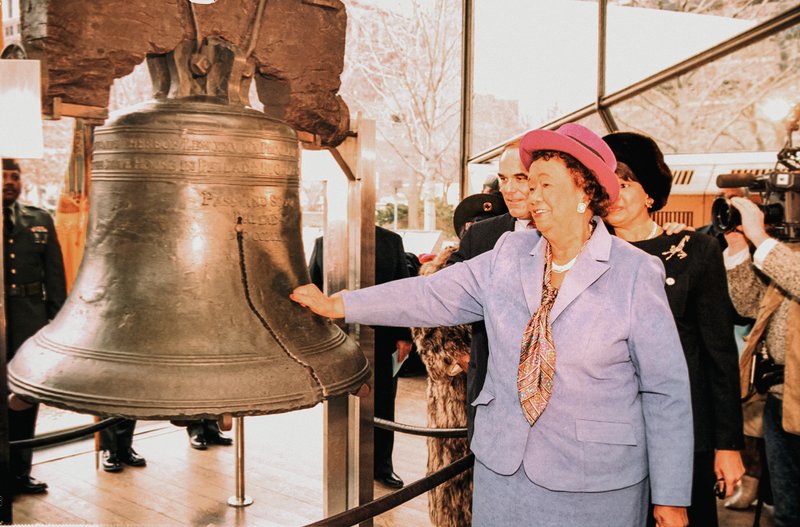
Dorothy Height, president of the National Council of Negro Women, taps the Liberty Bell to commemorate the birthday of civil rights leader Martin Luther King Jr. in Philadelphia, Jan. 20, 1992. Tapping the Liberty Bell is also a tradition on the Fourth of July. AP photo by Chris Gardner.
For years, the Liberty Bell was used to summon the city’s residents to community meetings and events. As it was on July 8, 1776, when it was apparently rung to convene the people of Philadelphia for the first public reading of the Declaration of Independence. That’s the story accepted by tradition, anyways. Some historians believe that since the steeple was under repair at the time, it is unlikely that the Liberty Bell was in use.
The bell got its famous crack while ringing in February 1846 to celebrate George Washington’s birthday. That’s why all it gets are a few taps.
Related: 10 Freedom Flicks to Watch This 4th of July Weekend
Independence Day, Danish-Style
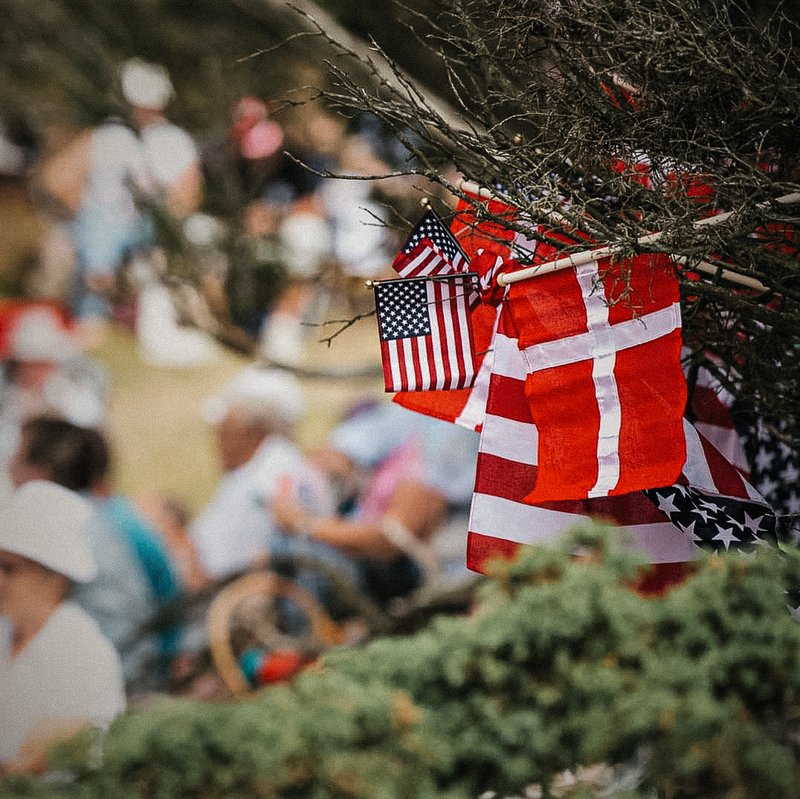
The Rebild Festival in Denmark first took place in 1912 and is considered the largest event celebrating the Fourth of July holiday outside the United States. Photo courtesy of the Rebild National Park Society.
On July 4, 1963, President John F. Kennedy delivered a patriotic message from Washington to a crowd of thousands gathered for an Independence Day festival at Rebild National Park in Jutland, Denmark. The Rebild Festival, which draws in a mix of Danes and Americans of Danish descent each year, is the largest July Fourth celebration outside of the United States.
Because Kennedy couldn’t be there that year in person, his speech was broadcast to the attendees over loudspeakers.
“The sight of the oldest flag in the world, the Danish flag, and the Stars and Stripes flying together, will remind us of the longstanding friendship and spirit of understanding which exists now between our two peoples and our two countries and must exist in the future as long as we both survive,” Kennedy said.
The annual tradition first began in 1912 after a group of Danish-American citizens purchased Rebild National Park for the specific purpose of using it as a venue for honoring the enduring alliance between Denmark and the United States, which dates back to the American Revolution.
As “hundreds of thousands of Danes [had] found hospitality and prosperity” on American soil, the group intended for the 450-acre park to serve as a shrine of sorts to the “love for the democratic ideals which Denmark has in common with the United States.”
Related: Danish Documentary ‘Armadillo’ Shows Unvarnished Reality of Afghan Combat
Nathan’s Famous Hot Dog Eating Contest
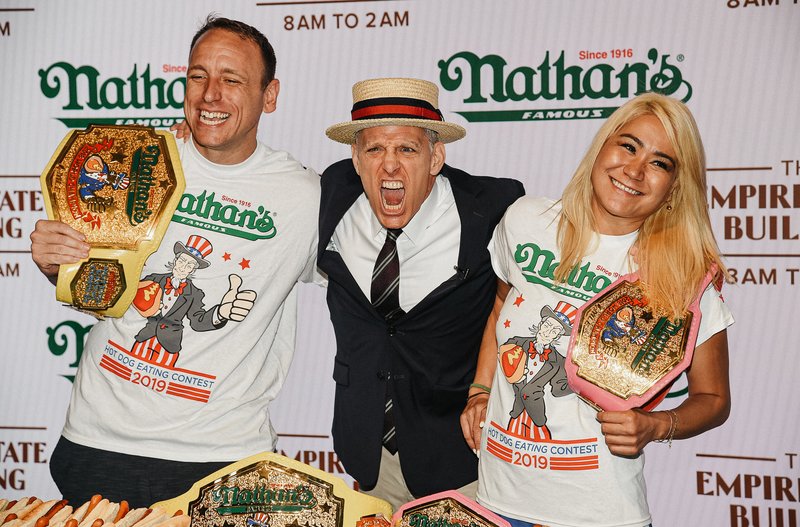
Eleven-time and defending men's champion Joey Chestnut, left, master of ceremonies George Shea, and defending women's champion Miki Sudo at the Nathan's Famous International Hot Dog Eating Contest weigh-in at the Empire State Building on Wednesday, July 3, 2019, in New York. AP photo.
In 1916, Nathan Handwerker, a Polish immigrant who had settled in Brooklyn, started a small business selling hot dogs on the Coney Island boardwalk. He made the hot dogs using his wife’s secret recipe and sold them for a nickel apiece.
As the story goes, on July 4, 1916, Handwerker and three of his friends challenged each other to a little hot-dog-eating contest. Whoever could eat the most hot dogs in one sitting would be deemed the most patriotic.
Since then, Nathan’s Famous International Hot Dog Eating Contest has been held every Fourth of July. In time, the event started drawing such a large audience that ESPN now broadcasts it live as a legitimate sporting event.
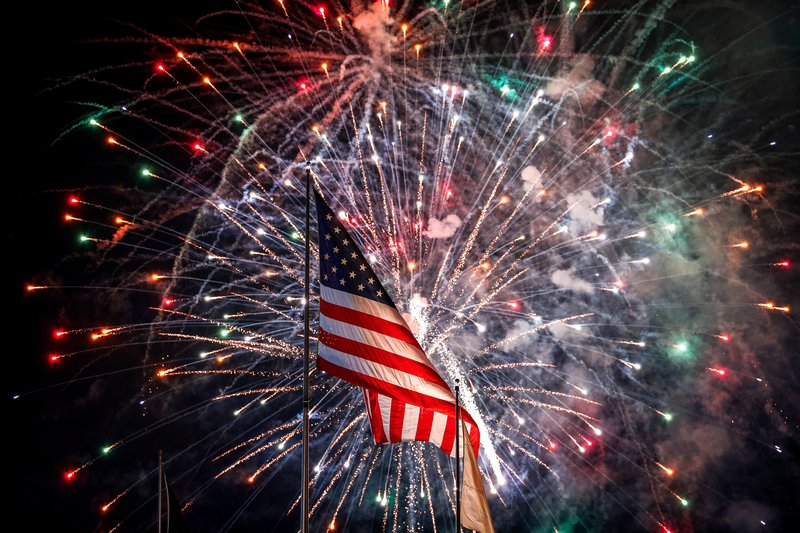
Fireworks explode behind a United States flag during a Fourth of July celebration at State Fair Meadowlands, Saturday, July 4, 2015, in East Rutherford, New Jersey. AP photo by Julio Cortez.
If the origin story of Nathan’s Famous Hot Dog Eating Contest sounds a little too quaint to be true, well, that’s because it is. For decades, nobody questioned the details, but in 2010, Mortimer Matz, a former B-29 navigator who had served in World War II before becoming a public relations mogul, admitted to The New York Times that he made up the story.
As it turns out, in the 1970s, Handwerker had hired Matz to craft a compelling backstory for the hot-dog-eating contest that would help “revive a tradition that dated to 1916.”
According to The Saturday Evening Post, the first contest took place on July 4, 1967. The winner was a 400-pound truck driver named Walter Paul, who inhaled 127 frankfurters in one hour. However, theories have circulated that Paul was also dreamed up by Nathan’s marketing team.

Matt Stonie poses for photographs after winning Nathan's Famous International Hot Dog Eating Contest men's competition, Saturday, July 4, 2015, in the Coney Island section of Brooklyn, New York. Stonie ate 62 hot dogs and buns in 10 minutes. AP Photo.
The first contest actually on record occurred in 1972. Melody Andorfor, an 18-year-old woman from Queens, ate 12 hot dogs (plus buns) in five minutes to take home the mustard.
In a way, the ridiculous fabricated backstories are very much in keeping with the spirit of the contest and its tone of faux-grandiosity. When introducing the contestants, for example, the announcer, referred to as the Master of Ceremonies, tends to employ language that evokes Homeric epics. The famous dog-eater Joey Chestnut was once described entering the arena as if “through the curtain of the aurora, a comet blazes to herald his arrival.”
Chestnut, who can eat up to 70 hot dogs in 10 minutes, is currently the undisputed champion of Nathan’s Famous Hot Dog Eating Contest. He has won the coveted Mustard Yellow Belt, the prize for first place, in 14 of the past 15 years. Naturally, he is an early favorite for 2023.
Other Odd Fourth of July Traditions
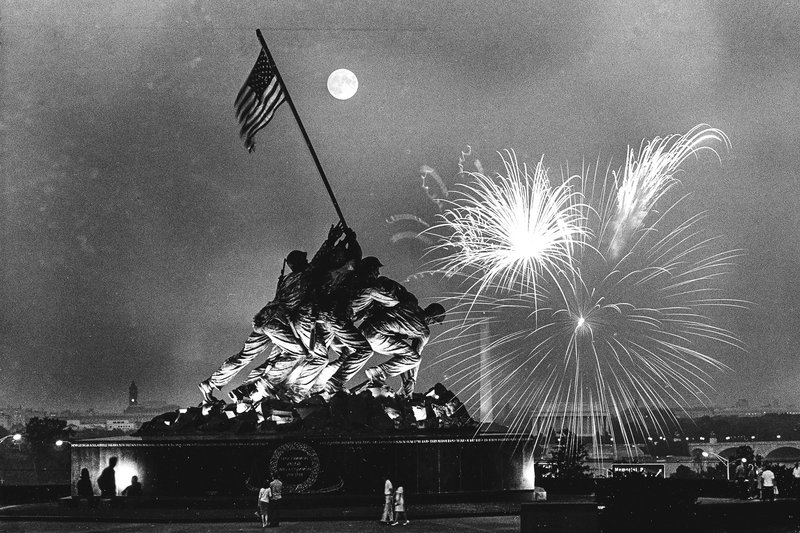
In this July 4, 1966, file photo, the moon shines above the United States Marine Corps War Memorial, which depicts a scene from Iwo Jima, as fireworks burst over Washington, seen from the Virginia side of the Potomac River. The Washington Monument and the Lincoln Memorial are seen in the background. AP photo by Charles Tasnadi.
- Giant Marshmallow Fight. Originating in the 1980s, the annual marshmallow fight at Ocean Beach in San Diego grew from local families tossing marshmallows at each other during a neighborhood barbecue to a massive crowd and sugary mess.
- Tug of War. The communities of Bolinas and Stinson Beach in San Francisco host a century-old tug-of-war event across the water separating the two communities.
- Lobster Race. New England hosts a lobster race in Bar Harbor, Maine, which is by no means fast-paced or thrilling, but at least you get a traditional dinner of poached salmon and egg sauce while the shellfish race. It’s also been voted one of the best Fourth of July celebrations by National Geographic.
- Fence Painting. Last but not least, leave it to the birthplace of Mark Twain — Hannibal, Missouri — to host a re-enactment of one of the most famous scenes in The Adventures of Tom Sawyer (sorry, no food is involved). Every year, thousands of people gather to watch as contestants dress up like characters from the book and race to paint their fence patch the fastest, like the gang that Sawyer persuaded to whitewash the fence for him.
Read Next: A Mysterious Bunker, Secret Rooms, and a Ghost: Myths of the Pentagon

Matt Fratus is a history staff writer for Coffee or Die. He prides himself on uncovering the most fascinating tales of history by sharing them through any means of engaging storytelling. He writes for his micro-blog @LateNightHistory on Instagram, where he shares the story behind the image. He is also the host of the Late Night History podcast. When not writing about history, Matt enjoys volunteering for One More Wave and rooting for Boston sports teams.
BRCC and Bad Moon Print Press team up for an exclusive, limited-edition T-shirt design!
BRCC partners with Team Room Design for an exclusive T-shirt release!
Thirty Seconds Out has partnered with BRCC for an exclusive shirt design invoking the God of Winter.
Lucas O'Hara of Grizzly Forge has teamed up with BRCC for a badass, exclusive Shirt Club T-shirt design featuring his most popular knife and tiomahawk.
Coffee or Die sits down with one of the graphic designers behind Black Rifle Coffee's signature look and vibe.
Biden will award the Medal of Honor to a Vietnam War Army helicopter pilot who risked his life to save a reconnaissance team from almost certain death.
Ever wonder how much Jack Mandaville would f*ck sh*t up if he went back in time? The American Revolution didn't even see him coming.
A nearly 200-year-old West Point time capsule that at first appeared to yield little more than dust contains hidden treasure, the US Military Academy said.












